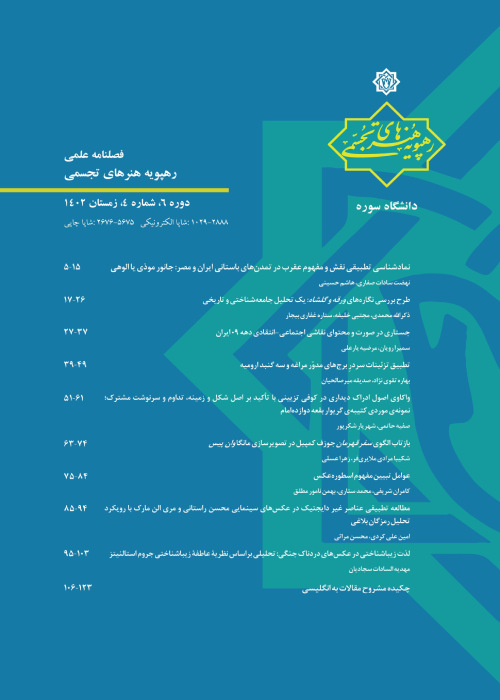Typology and Analysis of Baloch Motifs in Balochi Embroidery at Borders and Makran
Author(s):
Article Type:
Research/Original Article (دارای رتبه معتبر)
Abstract:
Needlework or Balochi embroidery is an art with history as long as the history of Sistan and Baluchestan. This art, rooted in the fabric of tribal life, reflects the taste of women in the mirror of eternal designs. The present paper intends to introduce, classify and provide a formal and semantic analysis of the main patterns and sewing techniques of Balochi needlework. So what are the most common designs used in needlework? And what are the factors affecting their creation? The authors first review and introduce the Balochi needlework designs, then study it in terms of form, category, and also in terms of content. Due to the lack of information on libraries, villages and cities in the Makran region and the borders of Sistan and Baluchestan, including Chabahar, Nikshahr, Iranshahr, Qasemabad Bampour, Irandegan, Marandgan, Saravan, Khash and Zahedan with field observations including interviews and questioning of artists acting needlework in naming and classifying patterns, used to analyze the subject. The results show that:Studies of the patterns and designs of traditional arts in terms of their oral transmission over the centuries, due to the lack of familiarity of many researchers with the concepts and language common among the local producers of these products have always encountered numerous problems. In answer to the research question, it should be stated that the most widely used Balochi needlework motifs include animal, plant, geometric and cosmic motifs. Human figures were not seen in this art, because of the beliefs adhered to in Baluch, but because of some of the signs that it has on humans or any other object, they adopt its name. Animal motifs were also seen more abstractly in Balochi needlework, which in most cases may have no resemblance to the original form of the animal, with only signs or part of the animal in the motifs, such as the death of a punch (chicken footprint). Due to the lack of flowers in Balochistan, plant motifs have led needlework to combine several geometric patterns to create works. These designs are sometimes completely abstract and sometimes realistic. Cosmic motifs include the moon and the sun and large and small stars, among other motifs, which are used to design these motifs of seals or hills. In Balochistan, colors have been influenced by tribal, historical and epic principles. Red, purple, crimson, orange, brown, and red in general make up 80 percent of color choices. In the villages, the pure color of the artist’s mind has been used, but in the city they have changed due to cultural and social influences. The way of life and the environment around the Baloch artist have been appeared so much in his designs and motifs that the play of colors and his emphasis on a number of designs can be clearly seen during his life; for this reason, some designs are specific to a city or village. In the dry and hot desert of Balochistan, a Baloch woman pursues her aspirations by creating the role of flowers, plants and combining colors, and creating a colorful and beautiful nature that is formed in her thoughts.
Keywords:
Language:
Persian
Published:
Journal of Rahpooye honar, Volume:4 Issue: 3, 2021
Pages:
59 to 74
https://magiran.com/p2386215
مقالات دیگری از این نویسنده (گان)
-
Iconological analysis of soldier and captive motifs in eight pieces of Safavid textiles
*, Marziye Esmaeeli
Journal of Visual and Applied Arts, -
Study of the Pictures and Epigraphy of the Stucco Altar of the Second Mosque of Bayazid Bastami from the Ilkhanid Era
Neda Goodarzi, *
Journal of Industrial Arts,



